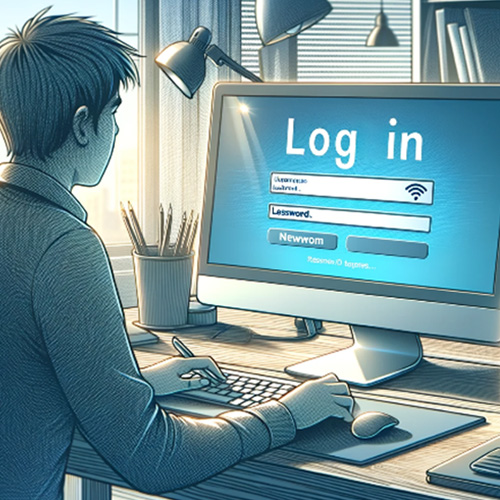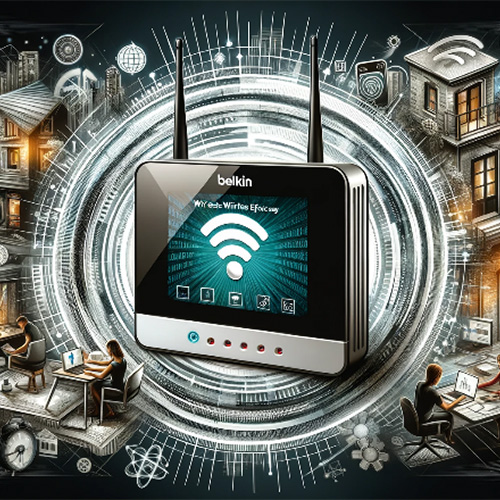Belkin Router Login
Welcome to the ultimate guide on Belkin Router Login. In today’s digitally connected world, having a reliable and efficient internet connection is crucial. Whether you’re working from home, streaming your favorite shows, or engaging in online gaming, your experience heavily relies on a robust network structure. Central to this structure is your Belkin router, a powerhouse of connectivity. However, the foundation of a seamless internet experience starts with understanding how to effectively log in and set up your Belkin router. 
Belkin router login
Logging into your Belkin router is the first step towards customizing and securing your home network. It’s essential not only for the initial structure but also for regular maintenance and troubleshooting. By mastering the Belkin router login process, you gain control over various aspects of your network, from setting up Wi-Fi passwords to managing guest networks and ensuring your online safety.
Navigating the Belkin Router Login Process
Gaining access to your router’s settings starts with the Belkin router login process. This crucial step is the gateway to customizing your network preferences and enhancing your internet security. In this section, we’ll delve into the detailed steps for logging into your Belkin router, specifically focusing on using the Belkin router login IP – a method preferred by many for its direct approach.
-
Step 1: Connect to Your Belkin Router
Ensure your device is connected to your Belkin router’s network. This can connect wirelessly to the Wi-Fi network of your Belkin router or wiredly via an Ethernet cable.
-
Step 2: Locate the Belkin Router Login IP
Most Belkin routers have either 192.168.2.1 or 192.168.1.1 as their default IP address. This Belkin router login IP is your portal to the router’s web-based structure page.
-
Step 3: Access the Router’s Interface
- Open web browser on your connected device.
- In the address bar, type in the Belkin router login IP, either 192.168.2.1 or 192.168.1.1, and press Enter. This action will take you to the Belkin router login page.
-
Step 4: Enter Login Credentials
Upon reaching the login page, you’ll be prompted to enter the router’s admin credentials. If you haven’t changed these before, the default username is often blank, and the password might be ‘admin’ or simply left blank. Refer to your router’s manual if you’re unsure.
-
Step 5: Explore Router Settings
- Once logged in, you’ll have access to various settings and features of your Belkin router. Here, you can change your Wi-Fi password, set up guest networks, update firmware, and more.
- If you have faced any problem related to Belkin router login password, you can visit the official website of Belkin for more information.
Advanced Tip: For those seeking a more advanced approach, using the Belkin router login IP offers a direct and efficient way to access your router settings. Those who are familiar with network administration, such as network administrators, will find this method especially helpful.
Troubleshooting Tips:
- If you’re unable to access the router’s login page, ensure the Belkin router login IP is entered correctly without any typos.
- In case the default login credentials do not work, consider if you have changed them in the past and use the updated credentials.
- As a last resort, you can reset your router to factory defaults by performing factory reset, but keep in mind that this will remove all of your configurations.
In summary, mastering the Belkin router login via the Belkin router login IP is an essential skill for managing and securing your home network. By following these steps, you can ensure that you have full control over your internet experience, from basic structure to advanced customization. If you still face the issues
Effortless Connection to Your Belkin Router
In the realm of digital connectivity, being able to connect Belkin router effectively is pivotal for a hassle-free internet experience. This section provides an in-depth guide on how to connect various devices to your Belkin router & troubleshoot common connection issues that may arise.
Step 1: Initial Structure of Your Belkin Router
- Before connecting devices, ensure your Belkin router is set up and powered on.
- Connect the router to your modem using Ethernet cable, and plug the router into a power source.
- Wait for the router’s lights to stabilize, indicating it is ready for connection.
Step 2: Connecting Devices Wirelessly
- On your device, navigate to Wi-Fi settings.
- Search for your Belkin router’s network name (SSID), which is usually provided on the router or in the documentation.
- Select the network & enter the Wi-Fi password. This information is also generally available on the router or in its manual.
Step 3: Connecting Devices Using Ethernet
- To establish a wired connection, immediately connect your device to a port on the Belkin router using an Ethernet cable.
- Wired connections are ideal for devices that require stable and high-speed internet, like gaming consoles or desktop computers.
Step 4: Verifying Connection
- Once connected, test your internet connection by opening a web browser and visiting any website.
- Successful access to the internet confirms a proper connection to your Belkin router.
Troubleshooting Connection Issues:
- If you cannot connect Belkin router to your device, restart both the router and the device and try again.
- Ensure the Wi-Fi password entered is correct. Remember, it’s case-sensitive.
- For wireless connection issues, reduce the distance between your device and the router to improve signal strength.
- Check for any firmware updates for your Belkin router, as outdated firmware can sometimes lead to connectivity issues.
- In case of persistent problems, resetting the router to its factory settings can help, but be aware this will erase all your current settings.
Advanced Tip:
For those who are more tech-savvy, accessing the router’s settings (as detailed in the previous section) allows further customization of your Wi-Fi network, such as changing the SSID or password for enhanced security.
By following these steps to connect Belkin router to your various devices, you ensure a robust and reliable home network. Whether it’s for streaming, gaming, or just browsing, a stable connection is key to enjoying your online activities. Remember, addressing any connection issues promptly and correctly is essential to maintain uninterrupted internet access.
Maximizing Wireless Efficiency: Navigating Belkin Wifi Router Login
In this digital age, ensuring optimal performance of your wireless network is crucial. In this section, we delve into tips for enhancing your wireless signal strength and performance, and provide guidance on accessing wireless settings through the Belkin wifi router login and Belkin wireless router login.
Part 1: Boosting Wireless Signal Strength and Performance
-
Optimal Router Placement:
Position your Belkin router in a central location, away from obstructions & interference sources like microwaves or cordless phones. This central placement helps in evenly distributing the Wi-Fi signal throughout your home.
-
Update Router Firmware:
Frequently check the Belkin wifi router login page for firmware updates. Keeping your router’s software up-to-date can enhance performance and security.
-
Adjust Wi-Fi Channels:
Through the Belkin wireless router login, access the settings to change Wi-Fi channels. Selecting less congested channels can significantly improve your network’s performance, especially in densely populated areas.
Part 2: Accessing Wireless Settings via Router Login
-
Accessing Router Settings:
Start by logging into your Belkin router. Enter the Belkin wifi router login or Belkin wireless router login IP address in your browser. The default IP is usually 192.168.2.1 or 192.168.1.1.
-
Navigating to Wireless Settings:
Once logged in, navigate to the wireless settings section. Here, you can manage your Wi-Fi network’s name (SSID), password, and other advanced wireless options.
-
Securing Your Wireless Network:
Change the default Wi-Fi password to a strong, unique one. This can be done under the wireless settings section post Belkin router login.
-
Utilizing Advanced Features:
Explore advanced features like guest network structure, Wi-Fi Protected setup (WPS), and MAC filtering for added control and security of your wireless network.
Troubleshooting Tips:
-
Rebooting the Router:
If you encounter issues after adjusting settings, a simple reboot of your Belkin router can often resolve minor glitches.
-
Resetting to Factory Defaults:
In cases where you cannot access the Belkin wifi router login, consider resetting the router to factory settings. Be mindful that this will erase all your custom settings.
By effectively managing your wireless settings through the Belkin wifi router login and Belkin wireless router login, and implementing these optimization tips, You can greatly improve your Belkin wireless router’s dependability and performance. This results in a smoother and more enjoyable online experience, whether it’s for streaming, gaming, or simply browsing the web.
FAQs – Addressing Your Belkin Router Queries
Navigating the intricacies of router structure and maintenance can sometimes be challenging. To assist you better, we’ve compiled a list of frequently asked questions (FAQs) addressing common queries related to Belkin router login, connect Belkin router, and various other aspects of router use and troubleshooting. These FAQs incorporate variations of both primary and secondary keywords to provide comprehensive answers.
Q: How do I perform a ‘Belkin router login’ for the first time?
- A: Connect your device to the Belkin router, open a web browser, and enter the ‘Belkin router login ip’, usually 192.168.2.1, to access the login page.
Q: What steps should I follow to ‘connect Belkin router’ to my Wi-Fi network?
- A: After logging in using ‘Belkin wifi router login’, navigate to the wireless settings to connect your Belkin router to your Wi-Fi network.
Q: I forgot my Belkin router login password’; how can I reset it?
- A: You can reset your password by accessing the router’s settings through the Belkin router login ip. Look for the password reset option under the admin settings.
Q: How do I find the Belkin router login ip to access my router’s settings?
- A: The default IP address is usually 192.168.2.1. Enter this in your browser’s address bar for ‘Belkin router login’.
Q: Can I use the Belkin range extender login to improve my Wi-Fi coverage?
- A: Yes, use the Belkin login wifi extender to configure your range extender and improve coverage.
Q: How do I change my ‘Belkin guest access password’?
- A: Log in using your Belkin router login, navigate to the guest network settings, and you can change the ‘Belkin guest access password’ there.
Q: What should I do if I can’t access the router using the ‘Belkin login ip’?
- A: Ensure you’re entering the correct IP address. If it doesn’t work, reset your router and try the default Belkin router login ip again.
Q: How do I configure advanced settings as a Belkin router admin?
- A: Access the router admin panel using ‘Belkin router login’ and navigate to the advanced settings section for configuration.
Q: Where can I get official support or firmware updates for my router?
- A: Visit the Belkin router website for official support, firmware updates, and additional resources.
Q: How do I ensure my Belkin wireless router login is secure?
- A: Change the default login credentials during your Belkin router login process to ensure your wireless router’s login remains secure.
We hope that answering these commonly asked questions will improve your knowledge of and ability to use your Belkin router. Whether it’s issues related to Belkin router login, connect Belkin router, or general troubleshooting, we hope these insights make your networking experience smoother and more efficient.
Conclusion: Harnessing the Full Potential of Your Belkin Router
As we come to the end of this extensive guide, let’s go over the essential points again so you can make the most out of your Belkin router. Mastering the Belkin router login is the cornerstone of managing and optimizing your home network. Whether it’s the initial structure or routine maintenance, understanding how to access and navigate your router’s settings is crucial.
-
Effortless Login and Structure:
We began by walking you through the Belkin router login process, emphasizing the importance of using correct IP address for access. This step is fundamental for both first-time structure and ongoing adjustments.
-
Seamless Connectivity:
Next, we covered the essentials of how to connect Belkin router to various devices. This ensures that all your gadgets, from smartphones to smart home appliances, enjoy seamless internet connectivity.
-
Optimization Tips:
We delved into optimizing your router for peak performance. From placing your router in an ideal location to updating its firmware, these tips are designed to enhance your Wi-Fi’s speed and reliability.
-
Troubleshooting Guidance:
Our FAQ section addressed common queries and challenges associated with Belkin router login and connectivity. This section aimed to equip you with the knowledge to troubleshoot basic issues independently.
We encourage you to explore beyond these basics. Your Belkin router is packed with advanced features waiting to be utilized. From setting up guest networks to implementing parental controls and enhancing security measures, there’s a plethora of functionalities to explore. Each feature is designed to offer you a more tailored and secure internet experience.
Should you require further assistance or wish to delve deeper into the advanced capabilities of your Belkin router, don’t hesitate to reach out to Belkin’s customer support. Their knowledge can offer you individualized advice and extra resources.
Remember, mastering your Belkin router login and familiarizing yourself with its features is not just about troubleshooting or basic structure. It’s about taking control of your digital life, securing your online presence, and optimizing your home network for an unparalleled online experience. Your journey with your Belkin router is just beginning, and a world of possibilities awaits.
To know more about Belkin Router and resolve its related issues, you can visit our Belkin Support.

